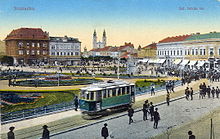
Subotica is a city and the administrative center of the North Bačka District in the autonomous province of Vojvodina, Serbia. Formerly the largest city of Vojvodina region, contemporary Subotica is now the second largest city in the province, following the city of Novi Sad. According to the 2022 census, the city itself has a population of 94,228, and the population of metro area stands at 123,952 people.
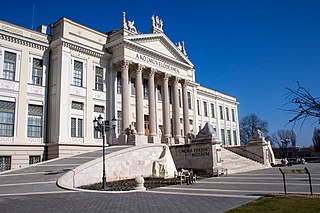
Szeged is the third largest city of Hungary, the largest city and regional centre of the Southern Great Plain and the county seat of Csongrád-Csanád county. The University of Szeged is one of the most distinguished universities in Hungary.

A tram-train is a type of light rail vehicle that both meets the standards of a light rail system, and also national mainline standards. Tramcars are adapted to be capable of running on streets like an urban tramway but also be permitted operation alongside mainline trains. This allows services that can utilise both existing urban light rail systems and mainline railway networks and stations. It combines the urban accessibility of a tram or light rail with a mainline train's greater speed in the suburbs.

Lake Palić is a lake 8 kilometres (5.0 mi) from Subotica, near the town of Palić, in Serbia. It covers an area of 3.8 square kilometres (1.5 sq mi). The average depth of the lake is 2 metres. With the surrounding area it forms the protected Nature Park Palić, which covers 7.25 square kilometres (2.80 sq mi).

Stari Grad is an urban neighborhood and the city center of Novi Sad, Serbia. In the Serbian language, the name "Stari Grad" means "Old Town".

The Bunjevac dialect, also known as Bunjevac speech, is a Neo-Shtokavian Younger Ikavian dialect of the Serbo-Croatian pluricentric language, preserved among members of the Bunjevac community. Their accent is purely Ikavian, with /i/ for the Common Slavic vowels yat. There are three branches of the Neo-Shtokavian Younger Ikavian dialect: Dalmatian, Danubian, and Littoral-Lika. Its speakers largely use the Latin alphabet and are living in parts of Bosnia and Herzegovina, different parts of Croatia, southern parts of Hungary as well in northern parts of the autonomous province Vojvodina of Serbia. Bunjevac dialect has been included in the list of official public administrative languages of the Subotica Municipality in Serbia since 2021. And Croatia added in 2021 the Bunjevac dialect to the list of protected intangible cultural heritage. Within the Bunjevac community and between Serbia and Croatia is for several decades an ongoing language battle about the status of Bunjevac speech.

Serbian Railways is a Serbian engineering and technical consulting company based in Belgrade, Serbia.
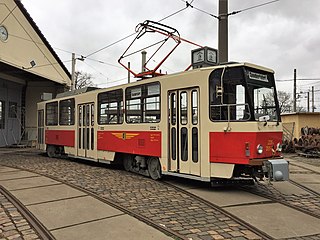
The Tatra T6A2 was a tramcar built by ČKD Tatra between 1985 and 1999. Having enjoyed widespread success with its previous models among mainly Soviet customers, the T6A2 was quite different in appearance to its predecessors, and was bought extensively by cities in the former East Germany, as well as by Szeged (Hungary) and Sofia (Bulgaria).

Transport in Zagreb, the capital of Croatia, relies on a combination of city-managed mass transit and individual transportation. Mass transit is composed of 19 inner-city tram lines and 120 bus routes, both managed entirely by Zagrebački električni tramvaj. Croatian Railways manages the parallel Zagreb Commuter Rail system. The city is served by the Franjo Tuđman Airport, which carries more than 3,300,000 passengers per year.
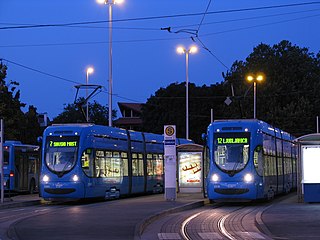
The Zagreb tram network, run by the Zagrebački električni tramvaj (ZET), consists of 15 day and 4 night lines in Zagreb, Croatia. Trams operate on 116.3 kilometres (72.3 mi) of metre gauge route. During the day every line runs on average every 5–10 minutes, but almost every station serves at least two routes. Nighttime lines have exact timetables averaging at about every 40 minutes. The first horsecar tram line was opened in 1891, and the first electric tram ran in 1910. Zagreb's tram system transported 204 million passengers in 2008.

The Łódź tram system is a tramway network located in Łódź, Poland that has been in operation since 1898.

The Belgrade tram system is a 1000 mm gauge network that in 2021 had 12 routes running on 43.5 kilometres (27.0 mi) of track in the city of Belgrade, Serbia. It is operated with 231 trams, including ČKD Tatra KT4, CAF Urbos, and Duewag Be 4/6 trams. The first tram line was introduced on 14 October 1892. In the late 2000s, complete reconstruction of the system commenced.

The tram system in Ljubljana, the capital of Slovenia, was originally built in 1901 and was operated until 1958. Slovenia was then part of Austria-Hungary and Yugoslavia, respectively. Work started in 1900 and the tram was put in use after postponements and without a special ceremony on 6 September 1901. The tram system's end came on 20 December 1958, when it was replaced in a ceremony by 12 buses.

The Niš tram system was a tram system in Niš, Serbia. It was in operation between November 16, 1930, to August 10, 1958.

The Gdańsk tram system is a tram network in Gdańsk, Poland that has been in operation since 1873. The tramway is operated by Gdańskie Autobusy i Tramwaje (GAiT) and managed by the Zarząd Transportu Miejskiego w Gdańsku. There are 11 lines with a total line length of 109.2 kilometres (67.9 mi). The system operates on 1,435 mmstandard gauge track.

The Novi Sad tram system was a tram system in Novi Sad, Serbia. It was in operation between 30 September 1911 until some time in 1958.
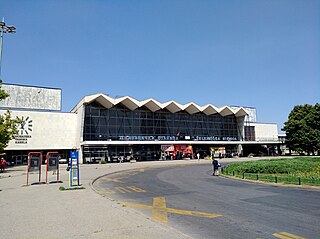
Novi Sad railway station is the main railroad station in Novi Sad, Serbia. The current station, located at Jaše Tomića Boulevard, was opened in 1964, after closing the old railway station from 1883 previously located at what is today the Liman fresh market. The station serves two daily high-speed trains to Belgrade and is part of the Budapest–Belgrade railway project.

Floriańska Street or St. Florian's Street is one of the main streets in Kraków Old Town and one of the most famous promenades in the city. The street forms part of the regular grid plan of Stare Miasto, the merchants' town that extends the medieval heart of the city, which was drawn up in 1257 after the destruction of the city during the first Mongol invasion of Poland of 1241.
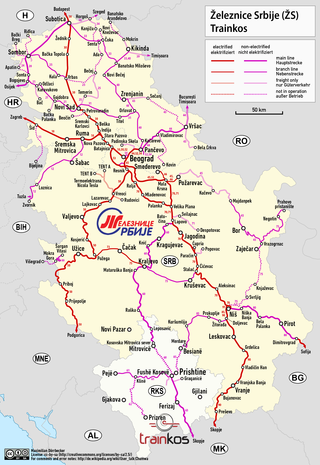
Srbijavoz is the national passenger railway company of Serbia. Srbijavoz is an associate member of the International Union of Railways (UIC) since 2016.
